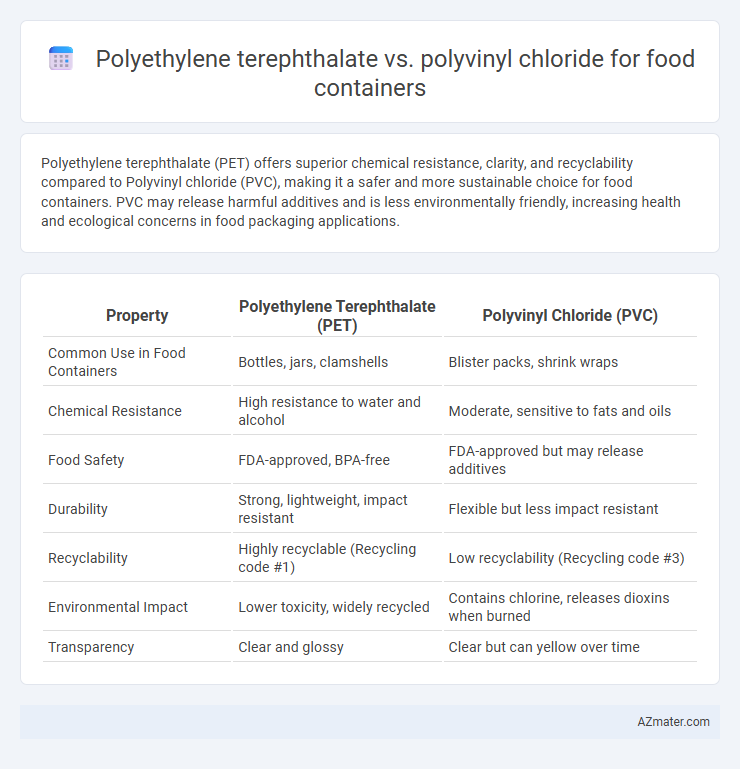Polyethylene terephthalate (PET) offers superior chemical resistance, clarity, and recyclability compared to Polyvinyl chloride (PVC), making it a safer and more sustainable choice for food containers. PVC may release harmful additives and is less environmentally friendly, increasing health and ecological concerns in food packaging applications.
Table of Comparison
| Property | Polyethylene Terephthalate (PET) | Polyvinyl Chloride (PVC) |
|---|---|---|
| Common Use in Food Containers | Bottles, jars, clamshells | Blister packs, shrink wraps |
| Chemical Resistance | High resistance to water and alcohol | Moderate, sensitive to fats and oils |
| Food Safety | FDA-approved, BPA-free | FDA-approved but may release additives |
| Durability | Strong, lightweight, impact resistant | Flexible but less impact resistant |
| Recyclability | Highly recyclable (Recycling code #1) | Low recyclability (Recycling code #3) |
| Environmental Impact | Lower toxicity, widely recycled | Contains chlorine, releases dioxins when burned |
| Transparency | Clear and glossy | Clear but can yellow over time |
Introduction to Food-Grade Plastics
Polyethylene terephthalate (PET) and polyvinyl chloride (PVC) are widely used food-grade plastics, each offering distinct properties suitable for food containers. PET is favored for its clarity, chemical resistance, and recyclability, making it ideal for bottled beverages and packaging requiring high barrier properties. PVC, while durable and flexible, is less common in food containers due to concerns over plasticizers and potential chemical leaching, limiting its use in direct food contact applications.
Overview of Polyethylene Terephthalate (PET)
Polyethylene terephthalate (PET) is a widely used thermoplastic polymer in food containers due to its excellent clarity, strength, and lightweight properties. PET offers high resistance to impact and moisture, ensuring prolonged shelf life and food safety without leaching harmful chemicals. Its recyclability and compliance with FDA food-contact regulations make PET a preferred choice over Polyvinyl chloride (PVC) for sustainable and health-conscious packaging solutions.
Overview of Polyvinyl Chloride (PVC)
Polyvinyl Chloride (PVC) is a widely used plastic in food containers due to its strong chemical resistance, durability, and excellent barrier properties that help preserve food freshness. PVC is a versatile thermoplastic polymer composed of vinyl chloride monomers, known for its rigidity or flexibility depending on plasticizer content, making it suitable for various packaging applications. However, concerns regarding potential chemical leaching and environmental impact have led to a preference for safer alternatives like Polyethylene Terephthalate (PET) in food packaging.
Chemical Composition and Properties
Polyethylene terephthalate (PET) is a polyester made from terephthalic acid and ethylene glycol, characterized by high strength, chemical resistance, and excellent barrier properties against oxygen and moisture, making it ideal for food containers. Polyvinyl chloride (PVC) is a polymer of vinyl chloride monomers with chlorine atoms in its structure, which provides strong chemical resistance but can release harmful additives like phthalates during food contact. The choice of PET over PVC for food containers is driven by PET's inert nature, safer chemical profile, and superior physical properties for maintaining food quality and safety.
Food Safety and Regulatory Approvals
Polyethylene terephthalate (PET) is widely recognized for superior food safety due to its inert nature, resistance to chemical leaching, and approval by regulatory agencies such as the FDA and EFSA for direct food contact. In contrast, Polyvinyl chloride (PVC) raises concerns over plasticizer migration and potential release of harmful additives, leading to stricter regulatory scrutiny and limited approval for food packaging applications. PET's high recyclability and compliance with established safety standards make it the preferred choice for food containers, ensuring consumer protection and regulatory adherence.
Performance and Durability in Food Packaging
Polyethylene terephthalate (PET) offers superior clarity, chemical resistance, and impact strength, making it ideal for food containers requiring durability and visual appeal. Polyvinyl chloride (PVC) provides excellent barrier properties against gases and moisture but can degrade under prolonged exposure to heat and may release harmful additives. PET outperforms PVC in terms of food safety, recyclability, and maintaining product integrity during storage and transportation.
Environmental Impact and Recyclability
Polyethylene terephthalate (PET) is widely favored for food containers due to its high recyclability and lower environmental footprint compared to polyvinyl chloride (PVC). PET is more readily accepted in recycling programs and produces fewer harmful emissions during processing, while PVC generates toxic chemicals such as dioxins when incinerated or improperly disposed of. The environmental impact of PVC includes persistent pollution and challenges in recycling, making PET a more sustainable choice for food packaging sustainability.
Cost Comparison and Economic Considerations
Polyethylene terephthalate (PET) is generally more cost-effective than polyvinyl chloride (PVC) for food containers due to lower raw material costs and higher recycling value. PET's widespread use in food packaging enables economies of scale, reducing production expenses compared to PVC, which also faces stricter regulatory compliance costs due to potential health concerns. Economic considerations favor PET as a sustainable, affordable option with better market acceptance and long-term cost savings in food container applications.
Common Applications in Food Containers
Polyethylene terephthalate (PET) is widely used for transparent food containers such as water bottles, salad trays, and fruit packaging due to its excellent clarity and high barrier properties against moisture and gases. Polyvinyl chloride (PVC) is commonly applied in rigid food containers like deli trays, meat packaging, and cling films, valued for its durability and chemical resistance but less favored for direct food contact due to potential chemical migration concerns. PET's recyclability and food safety certifications make it the preferred choice for single-use beverage and food packaging, whereas PVC is often restricted or used with specific additives to meet food safety standards.
Conclusion: Choosing Between PET and PVC
PET offers superior chemical resistance and safety for food storage, making it ideal for containers exposed to varying temperatures and acidic contents. PVC, while cost-effective and flexible, poses concerns due to potential leaching of harmful additives, limiting its suitability for direct food contact. Selecting PET ensures better food preservation and compliance with health regulations, emphasizing its preference over PVC in food container applications.

Infographic: Polyethylene terephthalate vs Polyvinyl chloride for Food Container
 azmater.com
azmater.com